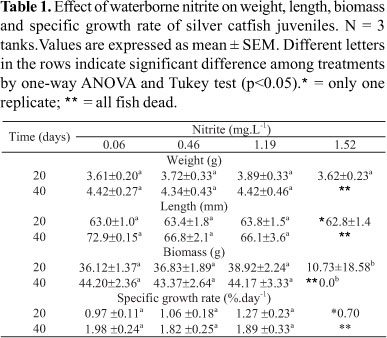High nitrite (NO2-) levels may develop in aquaculture systems due to high fish density, but studies of lethal concentration values and the effect of NO2- on metabolic parameters and growth are scarce. Consequently, in this study was verified the lethal concentration at 96 h (LC50-96h) for (NO2-) in juvenile silver catfish, Rhamdia quelen and the effect of four waterborne NO2- concentrations (0.06, 0.46, 1.19, and 1.52 mg.L-1) on growth, and hepatic and muscular lactate, glucose, glycogen and protein. Nitrite LC50-96h was 20.46 (confidence interval: 16.10-23.68) mg.L-1. In the growth experiment, exposure to NO2- did not affect weight, length or specific growth rate, but due to mortality (66.7% and 100% after 20 and 40 days, respectively), biomass of juveniles exposed to 1.52 mg.L-1 NO2- was significantly lower than the biomass of juveniles exposed to other treatments. Therefore, the safe level of nitrite for growth of silver catfish juveniles is below 1.19 mg.L-1 (2% of LC50-96h). Exposure of silver catfish to NO2- for 40 days reduced lactate levels in muscle, but lactate levels increased in liver tissue of fish maintained at 1.19 mg.L-1 NO2-. In addition, glucose levels in muscle and liver tissues were significantly lower in silver catfish exposed to the highest NO2- level. These results indicate that chronic NO2- exposure causes anaerobic substrate oxidation to meet energy demand.
Nitrogenous compound; Jundiá; Glucose; Lactate


